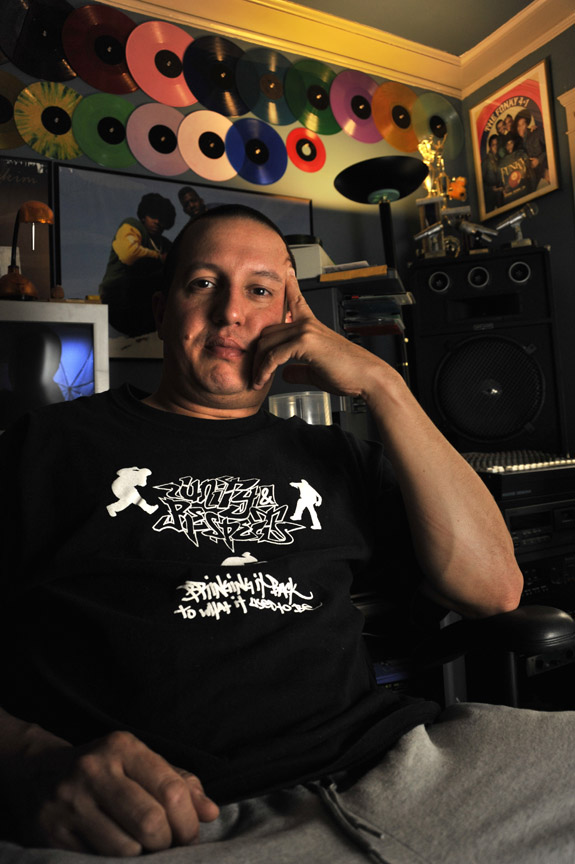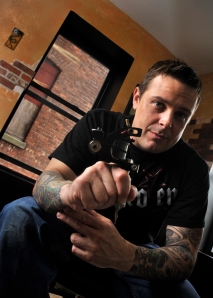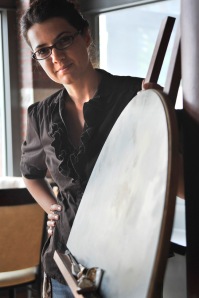Archive for July 2009
Bringin’ out the blacks
 |
Britt says …
|
My favorite color is black. However, when a black tee shirt blends into a black stereo system in the background, I’m not a fan.
Here I was, trying to shoot a semi-dramatic portrait of a DJ. I decide to shoot with a shutter speed of 1/250 to create a hard light on his face, and to not blow out the wall/ceiling behind him that is being lit by the floor lamp. By doing this, I ended up with little to no detail in my blacks, and every black object blending into one another. In this case, I want people to decipher the different DJ equipment in the room.
What to do, what to do? I want to love my blacks again..

 |
Scott says …
|
You need to put light on the things you want to see.
If you want to see the DJ equipment, then put some light on it. How to do that? Ambient is always a solution, but a poor choice in this case — you’d lose detail above the lamp and the shadows on his face. A backlight is a traditional way to provide separation between the subject and the background, especially when both are dark in tone. That solution might work for you here, but that room looks a little cramped.
I think your best choice would have been to light the background with a tight beam from a second flash. A snoot or grid would work great. I think I’ve mentioned this before, but some tinfoil provides a no-budget solution for snooting.
Some other comments on this portrait: You’ve got a reflection of your umbrella in his computer monitor (which you could’ve used as a secondary light source). You’ve got some bad merges between your subject and the junk behind him (that CD spindle growing out of his shoulder is especially distracting). And while I like the hand-resting-on-face pose, you didn’t do this guy any favors in the belly department. Perhaps a leaning forward pose would’ve been better, and still got you the low angle you needed for the background.
Remember that we get the luxury of control when we make portraits like this. We can set up our lights however we want. We can put our subject wherever we want. We can move things in the background if we need to. The picture is ours. We’re creating it, and we’re not trying to fool anybody into thinking we’re not. So own it.
Live music
 |
Britt says …
|
| Last Saturday I shot a hardcore show upstairs of the Palladium in Worcester, MA. Perfect place to shoot. I shot with my SB-800 on a TTL cord, doing the typical slow shutter, rear curtain flash shots. |
 |
| Here is a shot I took a band called A Loss for Words. I used the flash as shown above. |

|
| I turned the flash off, changed a few settings on the camera, and shot with the available light. |

|
| The two shots are of the same band, but have a totally different feel. The first gives me the local hardcore band performing to a crowd of rough and tough loyal locals. The second one feels like the band is performing at a stadium with a bunch of teenie boppers who idolize this guy with blonde hair who can sing. More decisions, decisions. |
 |
Scott says …
|
Somebody’s been thinking a lot about ethics. That’s a good thing.
While I don’t view your live music scenario as a weighty ethical dilemma, it does seem to me that you could use some parameters in which to frame your ethical choices.
My advice? Consider the audience.
If the audience for your pictures is the band and its fans, then I think you could shoot them however you want. However, if the audience is the readership of a general-interest publication that likely knows nothing about the band or hardcore shows or how all that looks, then you need to start considering the truthfulness of what your pictures show.
In your example, I think both pictures are fine and don’t cross any lines. But back to the parameters.
When I was starting out as a photojournalist and was trying to figure out how to think about shooting ethically, I used to do a little mental exercise. I would pretend that my entire readership — all 20,000 of them (or whatever) — was standing behind me as I took the picture. Seeing exactly what I saw. Would those people feel like what I put in the paper was an honest interpretation of what we all saw? If I could answer yes to that question, I was doing OK.
My little ethical exercise — pretending to have a crowd of witnesses — was a way to keep myself honest. I like it because it doesn’t get hung up on burning an dodging and f-stops and saturation, it’s just a simple gut-check: Am I trying to deceive people? If I am, that’s bad. But if I’m trying to show them a convincing representation of the world in an interesting way, well … that’s my job as their local newspaper photographer.
Decisions, decisions
Scott and I used to discuss the ethics and responsibility of taking photos for news. The choice to photograph Mayor Dennis Donohue as he smiles during a press conferance, or as he points into the crowd scowling is a big decision. The two images would tell two different stories, and could give the thousands of viewers a different opinion on the main man of Salinas. Now, I’ve discovered that lighting someone or something adds even more decision-making. Most people think flashes and extra light is used so that the subject will show up in the photograph. Yeah, that’s important, but it also gives a mood, and tells the story. I photographed a boxer/MMA fighter. Without thinking too much about it, I went with my instincts and put a harsh, dramatic light on him. By doing this, he looks so much more badass. I like it, he likes it, but is it true to who he is? Who am I to decide who these subjects really are? I do have to take their photo though, so do I set up a light that covers the space evenly and make every shot boring, or do I decide on the spot how to light them with a specific mood? A few more I played God with…
|
 |
Scott says …
|
Just for kicks, we should do some serious drama lightning on a cute teddy bear. That would illustrate the point you’re making in this post.
You’re right, Britt — you do get some real control over how people will perceive your subject based on how you choose to light them. But when you’re practicing photojournalism, it’s uncomfortable to have all that control. It feels wrong. Where’s the objectivity?
The photojournalism comes in when you get to know your subject. A quick conversation, a little research beforehand — sometimes it’s just reading what’s on your assignment sheet and going with your gut. You’re not going to light a kindergarten teacher with a grid spot, a fog machine and blue gels (although I would very much like to see that photograph), and you’re probably not going to pose your MMA fighter like he’s in a Sears portrait studio.
Or maybe you would. Maybe your MMA fighter is a softy, he raises bunnies and bakes cookies for old folks, and that’s what the story is about. Maybe you’ll ask him to hold a daffodil. Irresponsible? Too much power? Only if your photograph does not contribute to your readers’ understanding of the subject.
I know we’re both fans of David LaChapelle, who is definitely not doing photojournalism and certainly never plays it safe with his lighting (or anything else). But many of his portraits were made for print in magazines, to illustrate stories about the people pictured. So let’s consider, for example, this photo of Chris Rock. The fingerprint of the photographer is all over this one, but does it contribute to our understanding of Chris Rock as a person? I’ve listened to his comedy albums and I’m inclined to say yes. I would guess that Rock would endorse this image of himself. Plus, it’s a fantastic and fascinating picture.
In portraiture we get leeway to interpret. To make a judgment. So if your MMA fighter strikes you as a badass, make him look like it. Light him so he looks like he’s about to jump out from a dark alley and kick your ass.
Besides, what would you rather look at: A flat, safe, picture that objectively shows what the person looks like, or a living, dynamic portrait that suggests what the person is like?



